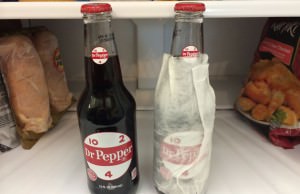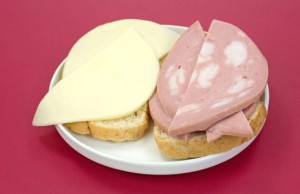21 Ways To Waste Less Food

It’s amazing to think about how much food people waste on a daily basis without even noticing. Following these tips will help you to avoid wasting food and obviously, stop wasting money as well.
1. MAKE GROCERY LISTS AND STICK TO THEM
The number one rule for those who continuously buy too much food and end up throwing it away is to start making grocery lists. More precisely – making grocery lists and sticking to them. Grocery lists are useful not only because they help you remember what you need to get, but also because they keep you from buying unnecessary things or too much food that will end up in the dumpster.
Before grocery shopping, check your fridge once again to see if you forgot to put anything on the list and also check if some of the food is about to run out or expire. If there is a carton of eggs in the fridge, but only one egg in it, obviously you need to put eggs on the list. In the store, buy only the food you put on the list. Even if something is on a crazy discount, if it’s not on the list – it’s not in the cart.

2. BUY FROZEN FOOD
People used to shun the frozen food isle because they thought there was no way frozen food can be just as nutritious as fresh food. Today we know that, thanks to the flash-freezing process, frozen food contains almost as much nutrients as the fresh one. Not to mention it’s often more affordable and certainly more convenient.
Frozen food stays good for a long time, certainly much longer than fresh vegetables, fruit and meat. This means that it almost never goes to waste, except of course if you forget it’s in the freezer and only remember it a few years after buying it, which is not very likely to happen. When you use frozen food for cooking, you can take only the amount you need and leave the rest in the freezer, so that’s another convenience too. Just remember that once it’s thawed, food should never be refrozen.

3. BUY ORGANIC MILK
Did you know that organic milk has a shelf life that is way longer than regular, non-organic milk? The same goes for dairy products like cream, butter and cheese.
The reason for this is the difference in the way milk is preserved. Organic milk is produced less commonly than “normal” milk and it has to travel further, which is why it needs to be protected with a more efficient method. Most types of organic milk are preserved through the UHT method or ultra-high temperature. The milk is exposed to very high temperatures for brief intervals of time.
On the other hand, non-organic milk is usually pasteurized, meaning it was exposed to lower temperatures. Because of this, organic UHT milk stays safe for consumption longer than the non-organic kind. This is definitely something to keep in mind when buying milk and dairy – with organic milk the chance of it going to waste is much lower.

4. DON’T MIX FRUIT AND VEGGIES
The way we store out food is a major factor in reducing the waste. Some fruits and veggies need to be kept in the fridge, others love the pantry and some need to be in the water. Most refrigerators have a veggie bin where people often keep all of their produce, without knowing that it’s not such a great idea, since fruit and vegetables actually cause each other to spoil faster.
Some kinds of fruit and vegetables hate being around each other, and some don’t really mind. But the general rule is that fruit and veggies shouldn’t mix. One of the reasons for this is that some fruit and veggies release ethylene as they ripen. Ethylene by itself is nothing to worry about because the small amounts of it are harmless to people, but since it promotes the ripening processes, it can make your produce too ripe too fast and cause it to spoil.

5. REMOVE BAD APPLES
You know what they say – “One bad apple can spoil the whole bunch.” The saying is usually applied to people but its root has to do with actual apples. One bad (rotten) apple in the bunch can really cause all the others to ripen too quickly and to rot, and it’s usually a matter of only a day or two, especially outside the fridge.
This happens because every fruit releases ethylene, which promotes ripening. Ripe, over-ripe or rotten apples release even more ethylene, which transfers to the other apples nearby, causing them to ripen and eventually rot, so you end up with a rotten bunch that needs to be thrown away. So, as soon as you notice an apple starting to go bad, throw it away or, even better, use the good parts and discard the rotten ones, but by all means separate it from the others.

6. KEEP SCALLIONS IN WATER
Scallions are amazing, delicious and versatile veggies that can be used in a variety of dishes, not to mention salads. Today we can buy scallions year-round and since they usually come in the bunch, and some recipes only call for one or two of them, we often end up with too much scallions that eventually wilt and shrivel, or, even worse, become slimy.
To keep the scallions fresh, take the rubber band off from the bunch and simply stand them in a jar filled with an inch or two of water, lust like flowers in a vase. For an even better effect, cover the jar with a plastic bag and put it in the fridge. The scallions will stay fresh up to a week. You can do the same with fresh garden herbs, Swiss chard and other leafy greens with a stalk that is long enough for it to stand in the jar.

7. SEPARATE BANANAS FROM THE BUNCH
Did you know that you can actually prolong the life of a bunch of bananas just by separating them? It sounds too good to be true, but it has been tested time and time again and it really works.
The reason for this is, yet again, ethylene. Ethylene is a gaseous hormone that causes the fruit to turn brown and ripen, and it works particularly hard when it comes to bananas. Because bananas come in bunches where they are very close together, the transfer of ethylene is particularly fast and that is why bananas turn brown and over-ripe so fast.
To prevent this, simply separate all the bananas so they no longer form a bunch. For an even better effect, wrap the stem of each banana in some cling foil, because it’s at the stem that most ethylene is produced. And if you really want your bananas to stay together, wrap the entire bunch in cling foil. And remember – bananas need to stay away from the fridge.

8. WRAP CHEESE IN SPECIAL PAPER
Cheese is a delicate thing and it can go bad (smelly, dry, moldy) very easily unless you know how to take care of it. If you want to prevent wasting cheese, avoid wrapping it in plastic at all costs.
There are special cheese bags and cheese paper that you can buy in any bigger supermarket, designed especially for storing cheese. They allow the cheese to breathe and at the same time they prevent it from drying up and turning into a brick. Alternatively, you can use wax paper or parchment. It is recommended to replace the paper every time you unwrap your cheese.
For cheeses that are kept in fluid (fresh cheeses), it is important to replace the brine as soon as you notice it might be a little funky. That way your cheese will last longer and you won’t have to throw it away before it’s all eaten.

9. FREEZE FRESH HERBS
So you bought a bunch of fresh thyme, basil, oregano and mint at the farmers market but only used a little bit for the dish you made? Now the herbs are wilting right in front of you and soon they’ll need to be tossed.
This is something that happens a lot because most herbs have very strong flavors and aromas and can only be used in small quantities. But there is no reason to throw away the leftover herbs when you can simply freeze them. This is particularly true for rosemary, thyme, sage and oregano.
They all freeze very well and retain their aromas to the fullest. Simply cut the herbs and place them in small plastic containers, Ziploc bags or even ice trays and place them in the freezer where they will be waiting for your next recipe. You can also freeze your herbs in olive oil or butter – it works even better.

10. USE ALL PARTS OF A FOOD
It may not sound like that to you, but throwing away parts of fruit, veggies and meat you are not using in a dish is a big waste. Almost every part of a food can be used for something, you just have to be smart about it.
For example, you can use radish and beet greens in salads. They are very nutritious and they taste great. Carrot greens can be used in soups and leek greens can make a great addition to a stir-fry, soup or salad. The same goes for cauliflower and broccoli stalks, as long as you chop them finely you can even eat them raw in a salad.
Even the parts of veggies like roots and stems that don’t look like much can be used to make vegetable stock. As for the meat, stock is again the answer for all those parts that seem “inedible,” like skin, tails, heads, feet and such.

11. MAKE STOCKS FROM SCRAPS
Stock is something that every person should have in his or her kitchen (fridge or freezer, to be precise). The clear broth is used to make a number of recipes, pretty much anything that requires fluids. Of course, you can always make your risotto with water instead of stock, but if you want it to be good, stock is the only way to go.
Another great side of stock is that it is made from scraps. You can make stock from whole chickens and brand new veggies, of course, but that’d be such a waste if you already have scraps. Pretty much every part of a vegetable can be used to make stock, which is not something we can say about other dishes.
Use carrot and zucchini trimmings, vegetable greens, whatever is left after making salad or any other vegetable dish. It’s all going to be strained out anyway. The same goes for meat. Do not throw away “yucky” parts of chicken or turkey – save them for stock!

12. REUSE DAY-OLD RICE
People in the East would be terrified seeing you throw away leftover rice from dinner. Plain white rice is perfectly good the next day, even a couple of days later, as long as you keep it in the fridge.
And there are many ways you can make use of it, instead of turning it into waste. Just try to cool it down as quickly as you can between cooking it and storing it in the fridge. You can use it to stuff peppers, tomatoes or zucchini, to make fried rice balls, burritos, stir-fried rice with veggies, Nasi Goreng (which is Malaysian and Indonesian fried rice), veggie burgers, soup, jambalaya, pilaf…You can even use it for baking cakes. The list is basically endless.
One of the simplest ways to enjoy leftover rice is to fry it with some scallions and carrots, maybe some curry paste or soy sauce, and voila! You have yourself a delicious lunch or dinner.

13. SAVE DRIED MUSHROOMS
Mushrooms are quite sensitive to external factors and it’s fairly easy for them to spoil. However, you don’t necessarily have to throw away those old mushrooms in the fridge – the key is knowing which are really bad and which just look bad.
If you keep your mushrooms in a plastic bag or even a plastic container, they will pretty soon develop brown spots and turn slimy, which is absolutely disgusting, not to mention unsafe. However, if you keep them in a paper bag in the fridge, they will shrivel and dry up. And this is a good thing – dried mushrooms are still good for eating!
Let them sit there in the paper bag and when they are completely dry, put them in a Ziploc and save them. The next time you need mushrooms, just add some hot water to them. They will rehydrate and reconstitute and be just as tasty as the fresh ones.

14. PICKLE ANY LEFTOVER VEGETABLES
If you bought too much vegetables and you are afraid you won’t be able to use it before it goes bad, why not pickle it? It’s a great way to preserve food, it’s easy and fun and not to mention it saves a lot of money. There are only a few rules of pickling and one of them is – don’t be afraid to pickle anything! People pickle all sorts of things, even watermelon rinds.
To pickle veggies, you will need some jars, vinegar, water, salt and spices of your choice. The most important part is the brine, which is very easy to make with equal parts of vinegar and water and some salt. For fridge pickling, you don’t need to worry about preserving the veggies, just make sure to eat them soon. If you actually want canned pickles, you need to boil the jars before filling them.

15. MAKE YOUR OWN CROUTONS AND BREADCRUMBS
You are not seriously throwing away that old, stale loaf of bread? If it’s not moldy, old bread can be reused and there is absolutely to need to toss it out. You can make your own croutons from scratch, or even breadcrumbs. It’s a great way to use the old bread and it also saves money.
To make croutons, cut the bread into cubes and drizzle them with some olive oil, sea salt, pepper, garlic and red pepper flakes. You can use oregano, thyme, sage, basil, pretty much any spice or herb you like. Place the cubes on a baking sheet and bake for 15 minutes at 400F.
Making breadcrumbs is even easier. If the bread is not completely dry and crisp, slice it and bake it for some 15 minutes in the oven. Let it cool and then simply toss it into a blender or a mixer. Like croutons, breadcrumbs should be stored in an air-tight container.

16. ADD CHEESE RINDS TO SOUPS
Even the biggest cheese-mongers among us stop and retreat in front of cheese rind. Although the rind is basically edible and safe, it’s nearly impossible to chew so most people naturally just throw it away after the block of cheese is done, or cut it away as soon as they first unwrap the cheese. This is a mistake, since cheese rinds can actually be used for cooking soups and sauces.
The trick that comes from Italian grandmothers teaches us that a little bit of cheese rind in the soup will make it taste so much better. The same goes for sauces, especially tomato sauce. Just save your cheese rinds, put them in a bag in the freezer and break off a little bit when you are making a soup or a sauce. The rind will melt and release the cheesy deliciousness and if it doesn’t melt all the way through you can always discard it or break it into smaller, chewy bits.

17. DONATE UNDESIRED FOOD
Donating food is the best possible way to deal with the food we don’t need, want or know what to do with. It happens to all of us – we sometimes buy much more than we need, especially if there is a sale or something. We end up with a pantry full of cans and jars and bags that we just know will expire before we get to use it. Canned food is actually very precious for food banks, soup kitchens and similar institutions. It has a long shelf life and it can make a great meal for someone.
Pretty much all bigger cities have a number of food banks. Find out about your and contact them. The banks often send someone to your place to pick up the food so you don’t even have to make the drive. And the benefits are obvious. You will sleep so much better knowing that not only you didn’t let any food go to waste, but you probably made someone’s day.

18. MAKE BANANA BREAD
Banana bread is the perfect waste-saving food because it actually requires old, brown bananas. It’s a delicious treat that goes great with coffee or tea, makes a great budget dessert and can even be used for breakfast because it’s very hearty and nutritious. On top of all that – it’s incredibly easy to make.
The banana bread recipe calls for a couple of ripe, almost completely brown bananas. The riper the better, in fact. Of course, you won’t be using bananas that are so ripe they split open and started to ooze. You will also need some sugar, flour, butter, an egg, a bit of salt and baking soda and some vanilla extract.
You don’t even have to use a mixer! Some people like to add chopped walnuts or hazelnuts, or some raisins that have previously been soaked. So the next time you end up with bananas you no longer want to eat, give banana bread a shot.

19. USE TUPPERWARE
You know that Tupperware is actually supposed to be used for food, not just as an excuse to throw parties, right? Tupperware and similar dishes are actually great food-savers and helpers in the fight against food wasting. They are designed to keep the food fresh as long as possible, and they come in a variety of sizes and shapes. Along with chips clips, cookie tins, Ziploc bags, foil and paper, they make a great investment that pays off quickly.
Tupperware is great because its main purpose is to prevent your food from going bad. The longer your food stays good, the bigger the chances you’ll actually eat it, instead of throwing it away. This kind of kitchenware also helps you maintain an organized fridge and pantry, which is an important part of avoiding waste. Pretty much every house has at least some Tupperware. So dig your out and start using it today.

20. AVOID SINGLE-SERVE COFFEE MAKERS
Single-serve coffee makers have become very popular over the last ten years. Brands like Keurig, Nespresso, Tassimo and others offer coffee makers that allow you to enjoy your favorite beverage almost completely mess-free.
The experience is really enjoyable, we’ll grant them that. These coffee makers are fast and the coffee they make is delicious. But there is one problem – they’re a terrible waste of coffee. Single-serve coffee makers use little pods or capsules filled with coffee. The machine pierces the pod, instills water and makes the coffee. The pod is discarded after use. Some have tried reusing them, but the result was disgusting.
When you consider the amount of coffee in each disposable pod, you’ll realize that you’re overpaying for your cup several times. Not to mention that little plastic pods are horrible for the environment. But if you already have a Keurig or a Nespresso machine, at least try using reusable filters instead of pods. It will save you both the coffee and the money.

21. MAKE COMPOST
Compost is the single best way to maintain the sustainable cycle between the earth and the food we eat. If you have a garden, there is absolutely no excuse for not making compost.
And even if you live in an apartment or a house with no garden, you should look into smell- and pest-free ways for indoor composting. Compost is an organic matter that can be used as a fertilizer and soil conditioner. It is essential in organic farming and gardening since it’s completely free of non-organic additives.
The simplest way to make compost is to make a heap of green waste, which consists of fruit and vegetable leftovers, as well as skins, seeds, roots, leaves, pretty much anything you haven’t used and thought of throwing away. The heap should be watered regularly and after some time, usually a couple of months, it will turn into fertile, rich humus that you can use in gardening.









